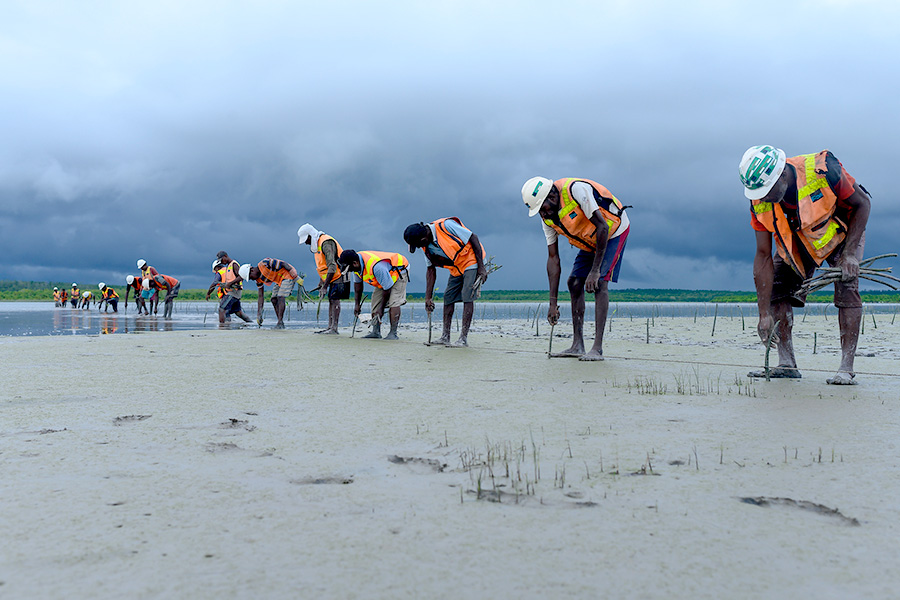23 March 2022

From 2004 until now, PT. Freeport Indonesia through the Ministry of Environment has been aggressively planting mangroves throughout the newly formed island due to tailings sedimentation from mining operations. In early 2022, PTFI again planted 500 mangrove trees on an area of 1 hectare on Puriri Island, to be precise at the mouth of the Ajkwa river. The type of mangrove planted is Rhizophora mucrona, based on the results of trials conducted for many years, the type of Rhizophora mucrona is the best and can produce other types.
"What we are currently planting is the Rhizophora mucrona type with long fruit. When this species grows, the seeds of other types will be stuck at the roots, then they will grow naturally. PT. Freeport is always committed to doing environmental management including trying to maintain the formed islands," said PTFI General Superintendent Reclamation Biodiversity and Education, Robert Sarwom at the Ajkwa estuary, Friday (25/2/2022). Apart from Rhizopora mucrona, since 2004 there have been six types of mangroves planted and one of them is nipah (Nypah fruticans), a type of pandanus or sago that grows in swampy and wet areas.
Robert explained, in the mining operations carried out by PTFI, there will be impacts that are mostly managed in dry areas, in the highlands and the lowlands. One of the environmental management parts is tailings deposited in the lowlands because the finer tailings particles will be carried by water currents to the estuary and settle, thus forming new deltas or islands.
To date, PT Freeport Indonesia's Department of Environment has planted approximately 2.6 million mangrove trees on 450 hectares of land or islands. These islands were later named as new islands, which in the Kamoro language is "Wai".
The islands were formed due to sedimentation, which was also formed not 100 percent due to tailings. However, there is naturally mixed sediment, namely the finer tailings carried by the current and deposited at the bottom of the estuary. These fine tailings are very suitable for mangrove habitats because mangroves grow in mud areas. "These fine tailings are in the form of mud and have the potential to be overgrown with mangroves. With the formation of a mangrove ecosystem, it does not directly open or improves the ecosystem in the estuary," he said.
Based on the results of monitoring, in estuaries that have been planted with mangroves, many migratory birds of the Pelican species come to make stopovers or build nests. With the colonization of mangroves, the number of fish will increase, because different types of fish will appear in the planted area to lay eggs, nest, and breed. Thus, of course, attract pelicans. "You could say, if the place is empty, after planting mangroves, it will return to being a habitat favored by various types of animals, especially birds," he mentioned.
This mangrove planting program does not directly involve the general public. This program invites people who have areas in that area to form a business entity as a contractor where then PTFI provides reclamation. "Currently, two contractors are collaborating, namely CV. Asibendaam and CV Kapare. The budget for the mangrove planting program is made in a one-year contract with the contractor. Each contract is Rp1.6 billion. In one contract, planting is carried out on an area of 70 hectares, " he revealed.
During the year, apart from planting, the contractor also re-embroidered. This is because the failure is not caused by pests and diseases. "Mangroves don't need special care, they just need to be maintained and replanted," he explained. One of the causes of damage or failure of mangrove growth and development is human activity. For example, logging and community boats passing over mangrove areas that are currently growing.
Until now, the success of this mangrove planting program has reached 90 percent. The failure usually occurs due to abrasion. Abrasion occurs because the land is in the estuary, so it gets pressure from two sides, which is when the sea water recedes there will be current pressure from the river and when the sea water is high it gets pressure from the sea, so the plants are easily damaged. To anticipate or reduce the number of failures, planting is done with a tight distance, so that the roots are tied together and not easily abraded.
It is hoped that this mangrove planting program can maintain the land formed so that the island in Papua will be even more powerful. It is also hoped that it could be useful for the community as a place to look for marine life. On the other hand, the mangrove planting program is very helpful for the government in reducing the greenhouse effect. In this case, with the planting of mangroves, the open land will decrease, thereby reducing the greenhouse effect.
Meanwhile, the direct impact on the community is getting the results of what they do. The rest of the community will also increase the area of the livelihood. "The main inhabitants of the mangrove forest are fish, so it will make it easier for people to catch," he said.
It was further stated that with this planting, the mangrove forests in Papua will be more protected. Mangrove forests in Papua are recorded as mangrove forests that are still maintained compared to mangrove forests in other areas. Of the 3.6 million hectares of mangrove forest in Indonesia, there are 1.6 hectares in Papua, of which 300 hectares are in Timika along approximately 340 km.
"Thus, what PT. Freeport has done, it can maintain the condition of mangrove forests in Papua. As long as new island deposits are formed during PT. Freeport's operations, mangrove planting will also continue. For locations affected by sediments Planting will be carried out up to 100 percent," he said
http://www.salampapua.com/2022/03/freeport-gencar-tanam-mangrove-di-pulau.html
Kami menghimbau para pencari kerja untuk berhati-hati dan mewaspadai beragam modus penipuan perekrutan yang mengatasnamakan PT Freeport Indonesia. Dalam setiap proses rekrutmen dan penerimaan karyawan, PT Freeport Indonesia maupun konsultan rekruitmennya tidak memungut biaya apapun.
Untuk melihat lowongan, silakan akses melalui link berikut: ptfi e-recruitment
Untuk melihat informasi magang, silakan akses melalui link berikut: Internship Program
